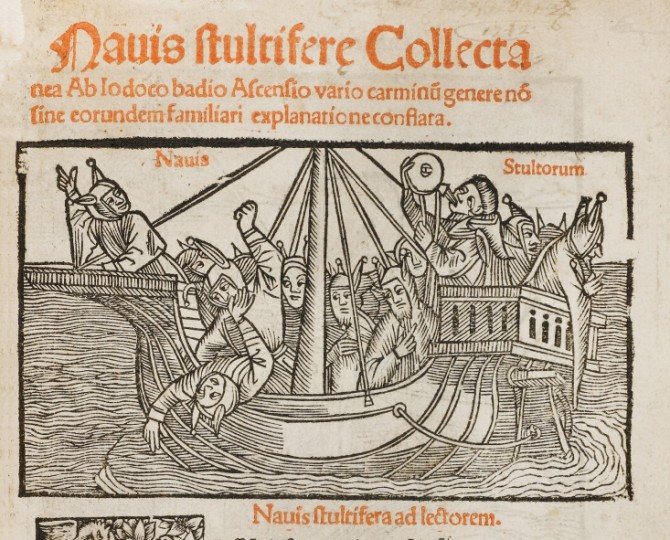RARE BOOKS: SHIP OF FOOLS BY SEBASTIAN BRANT

Among the most important works of European literature, there is without a doubt the renowned Ship of Fools by humanist Sebastian Brant (1457-1521), firstly published in Alsatian dialect in Basel during the 1494 Carnival. The poem describes the imaginary and ludicrous voyage of a ship of fools first to the country of Narragonia, then on to “Schlaraffenland”, namely the land of Cockaigne, and finally the disastrous shipwreck, a metaphor for eternal punishment. The didactic-satirical work, disguised as an allegory, chastises the numerous human vices and the foolishness of a society including representatives of all social classes, from the clergy to the nobles, the merchants and the peasants, dealing with all possible weaknesses from greed to adultery and gluttony.
All things considered the garment of foolishness express the shadow that accompanies human life; its tragic dimension embodies both horror and fascination for the unknown, the dark, the extreme, Evil and Death, all that in short constitutes the limit of Reason. As Diderot and D'Alembert recalled in their Encyclopédie of the 18th century, fools are, etymologically speaking, those who stray from the normal path of Reason. The concept of foolishness was a widespread figure of speech in the ante-Reformation period to justify criticism, used in particular by Erasmus of Rotterdam in his famous Praise of Folly. The court jesters were allowed to say almost anything they liked.
The book immediately gained widespread popularity, evidenced by the numerous authorised and unauthorised editions, and the rapid translations into Latin, French and English.
In the spring auction catalogue we will present a copy of the rare Parisian edition, printed by Jean de Marnef and osse Bade in 1513 and enriched with 115 three-quarter xylographs. The work owes most of its success to its illustrations. Brant, born in Strasbourg but who lived in Basel where he lectured at University, was one of the first to understand how to use printing in a modern way.
He gathered a team of illustrators, the most important of which was Albrecht Dürer, who engraved the beautiful large-format xylographs that illustrate his work.
The representation of the foolish academic surrounded by books is well-known. Books are everywhere, on the shelves, behind him, by the side of the bookstand, and inside the cabinet doors. The man wears a nightcap, a jester's cap hangs on his back and he holds a feather duster to shoo away the flies landing on the books. A pair of glasses sit on his nose, among other things, one of the first representations of this necessary sight aid. He is the one "crazy about books", the fool who buries himself in volumes.
"If on this ship I’m number one for special reasons that was done, yes, I’m the first one here you see because I like my library. Of splendid books I own no end, but few that I can comprehend", says Brant's Book Fool. The xylographs representing the wheel of fortune, frivolous love, vanity, greed, envy and self-praise are just as well-known. It creates an irresistible, tragic, yet humorous "dance of death". This colourful "party of fools" is horrible and cheerful at the same time and its extraordinary playfulness is a source of fun as well as a moment of careful reflection. The renowned American bibliography Printing and the Mind of Man, number 37, states that the text represents "the most important of a long line of moralizing works in which the weaknesses and vices of mankind are satirized as follies”. Recently the term bibliophily has sometimes been replaced with bibliofolly!
THE AUCTION CATALOGUE